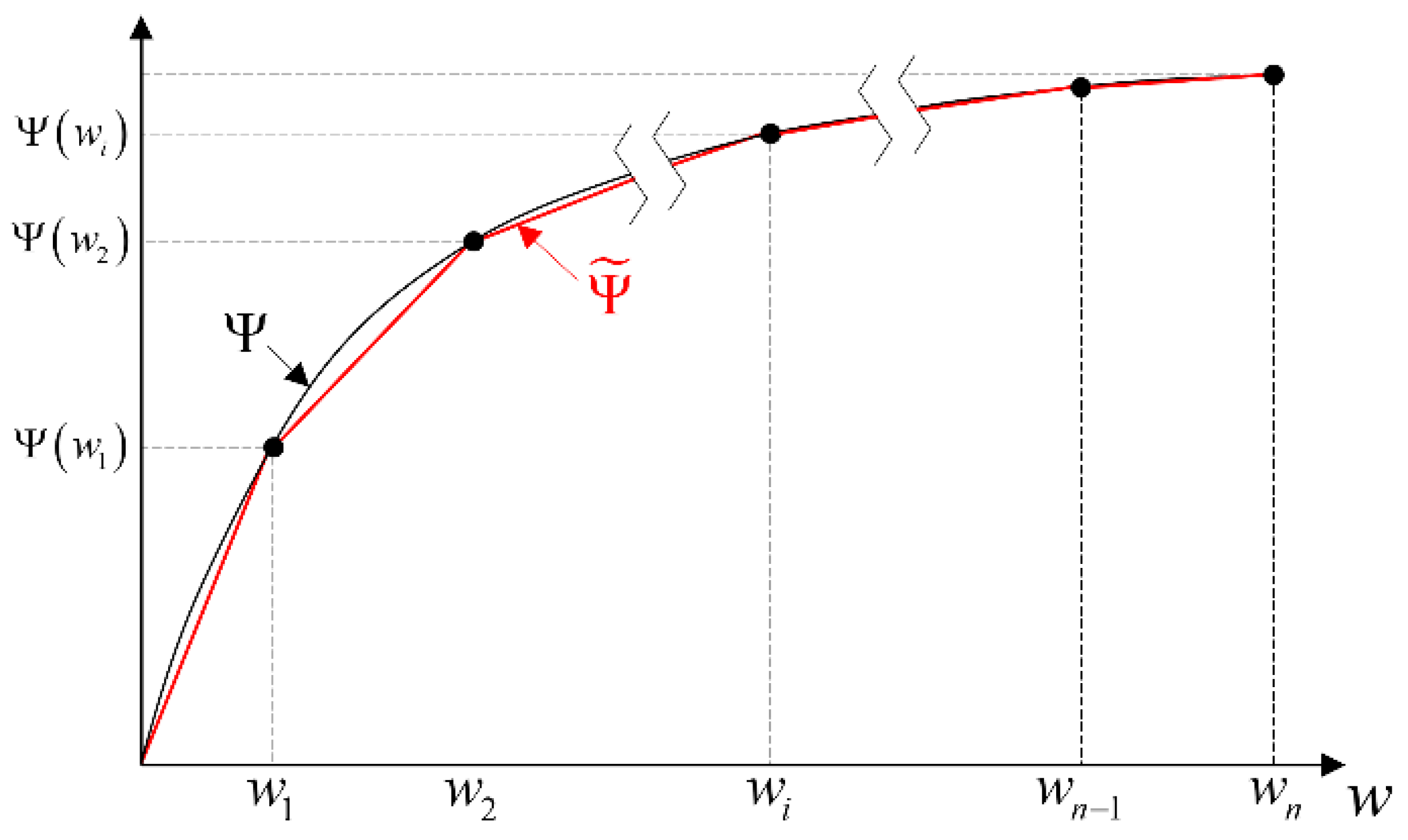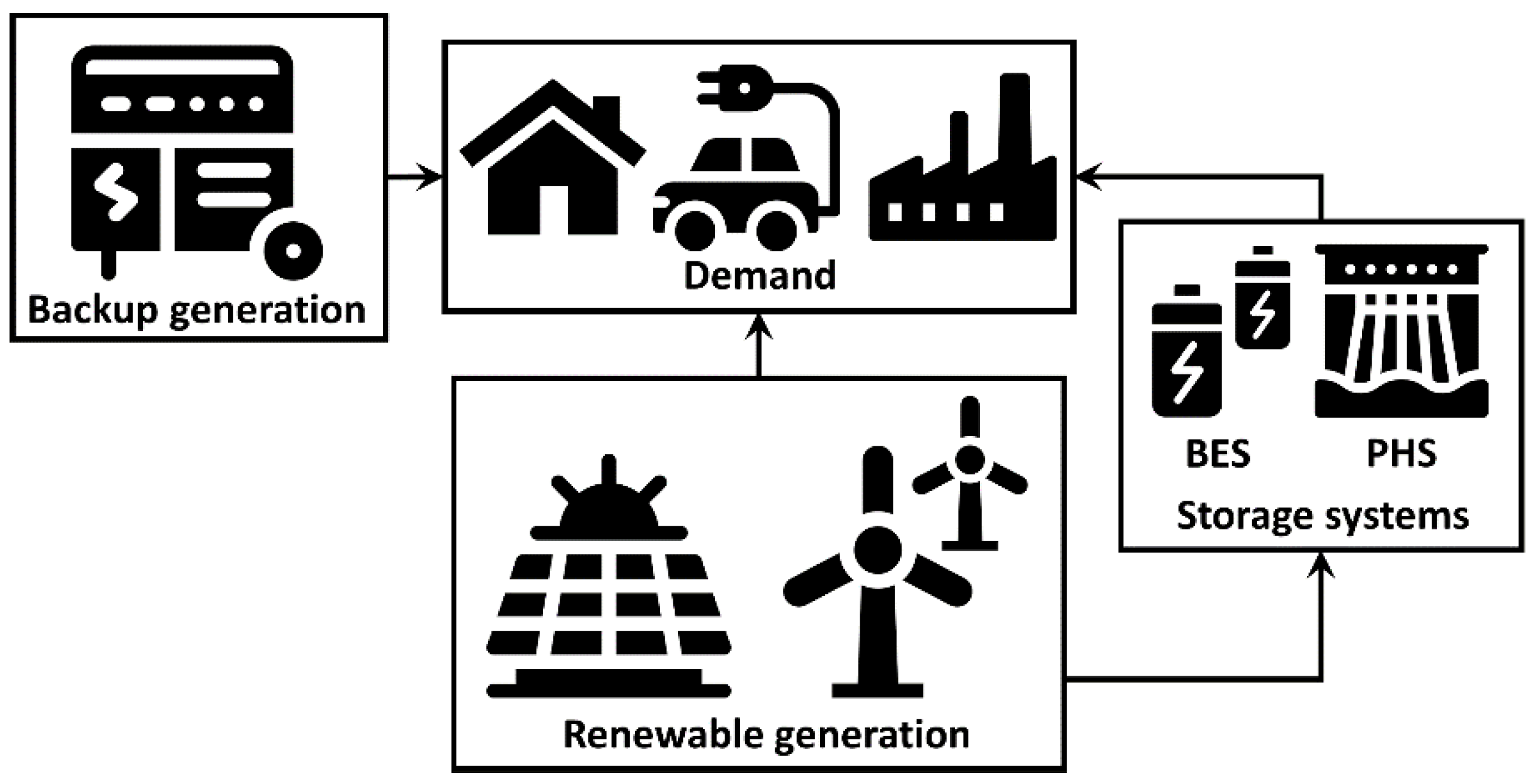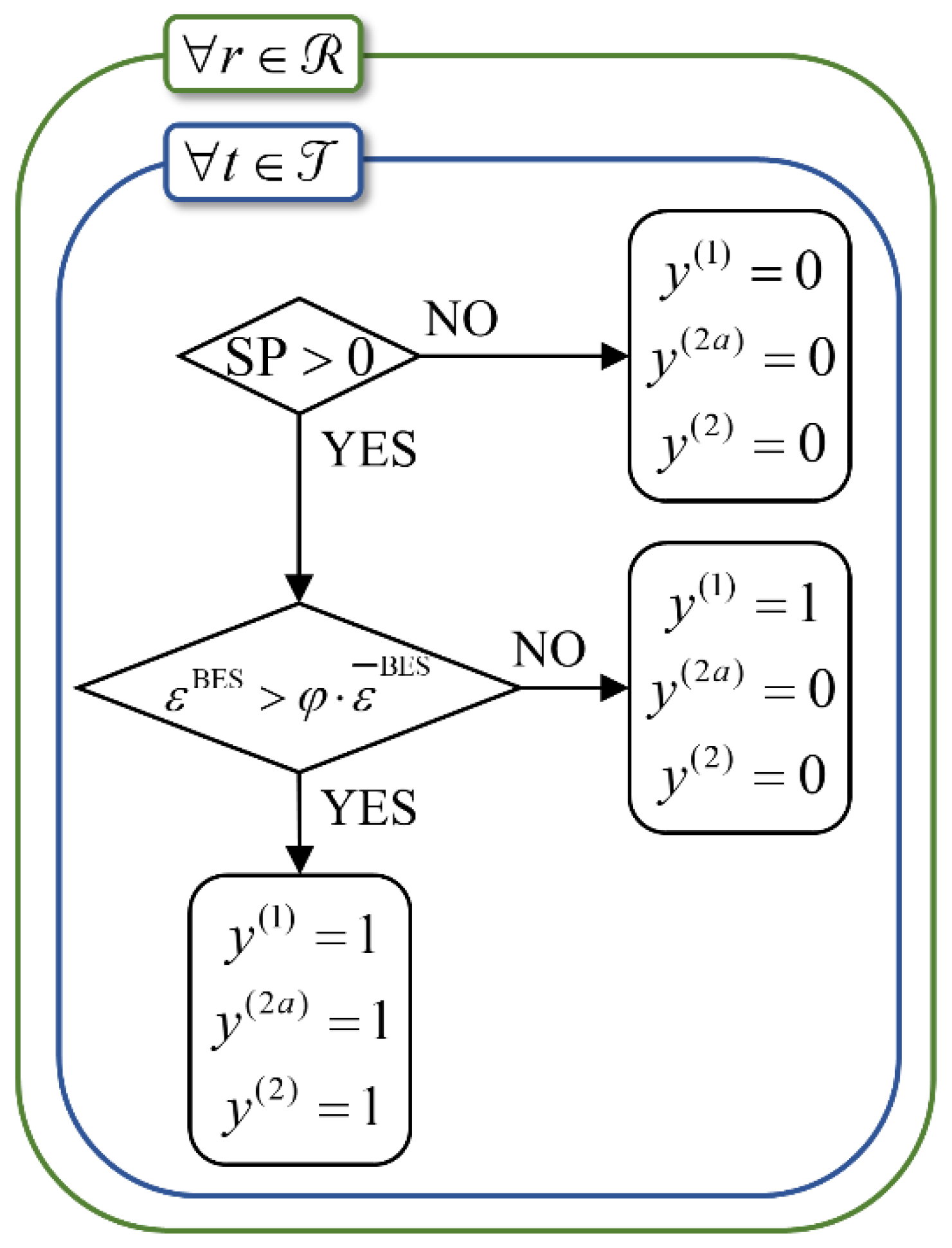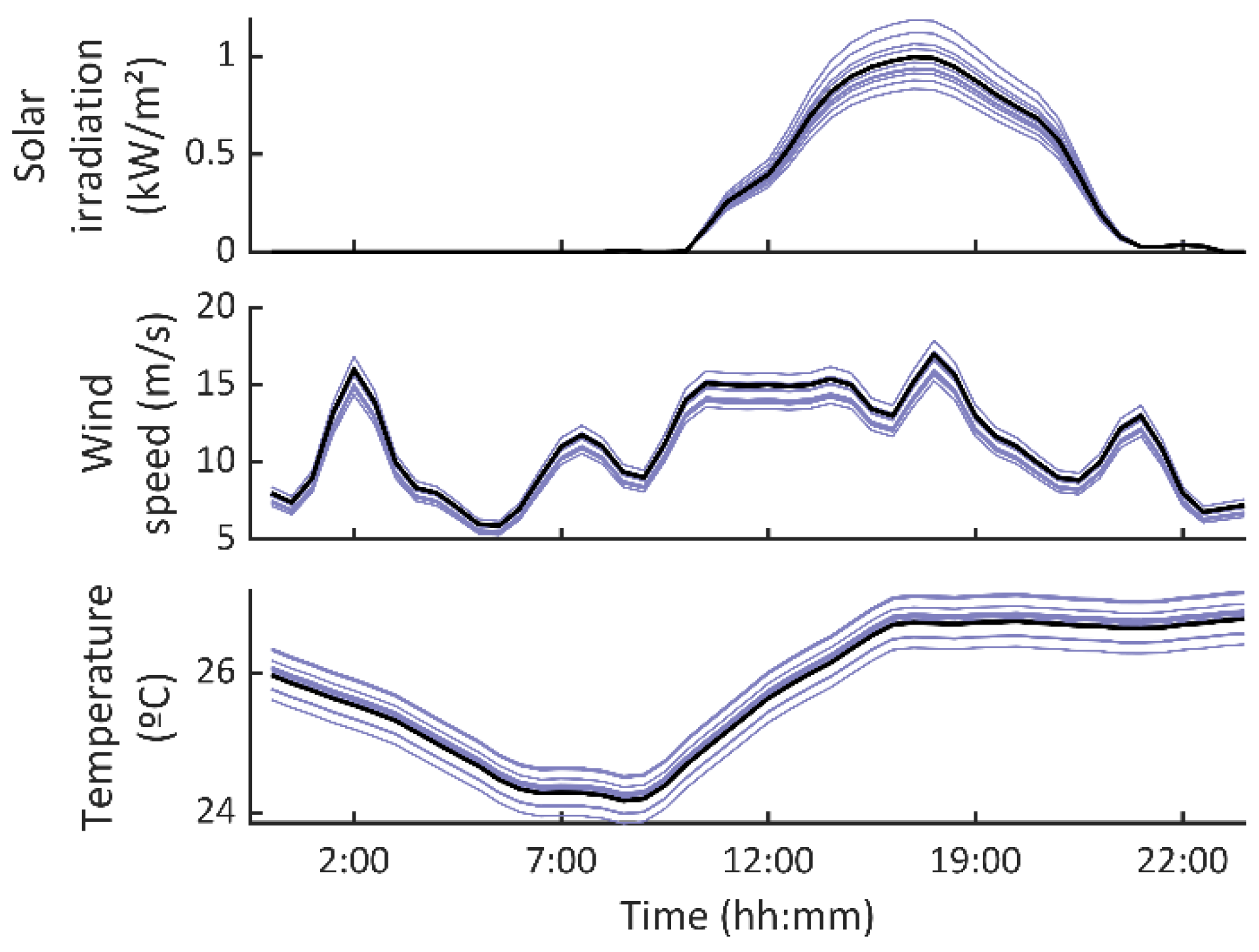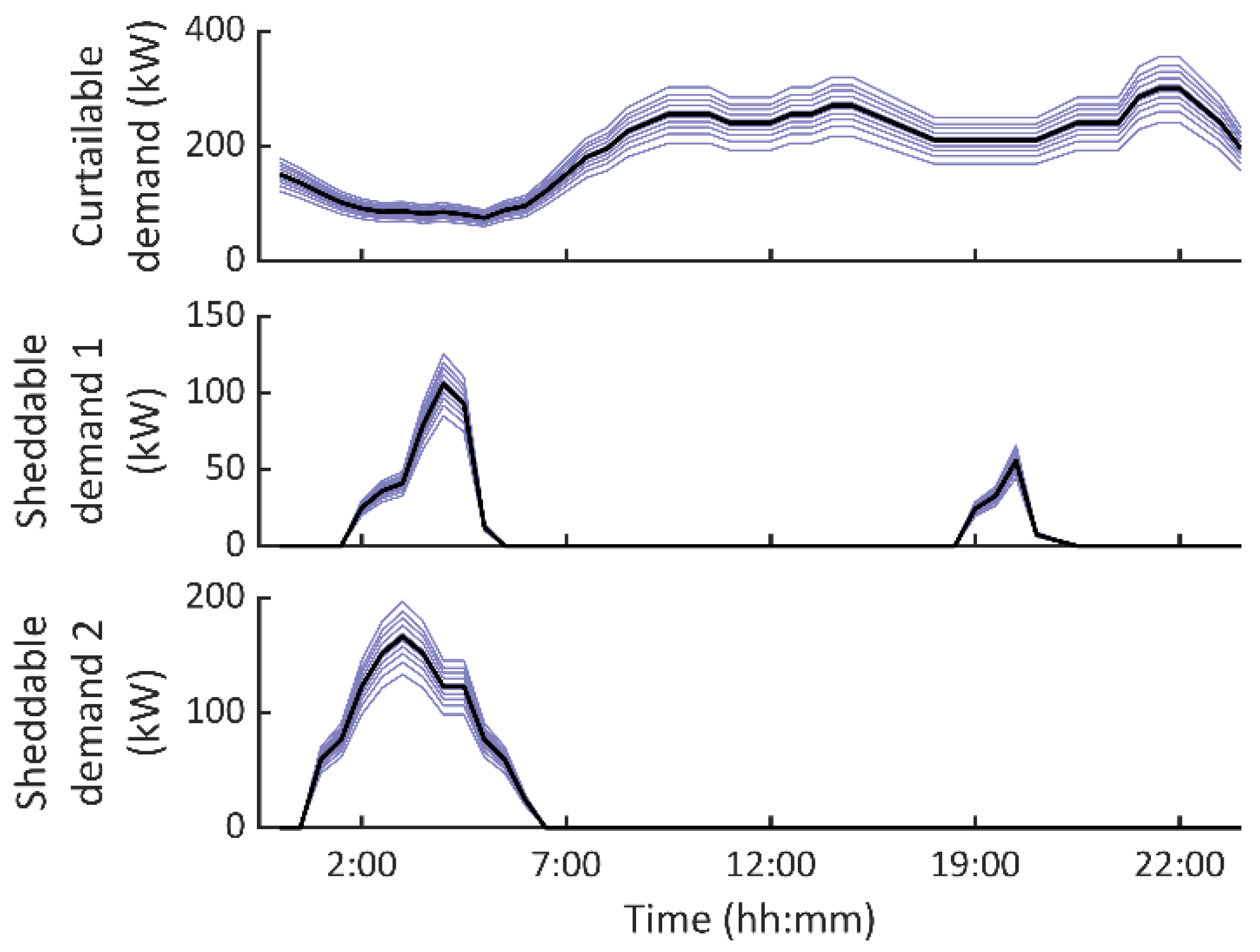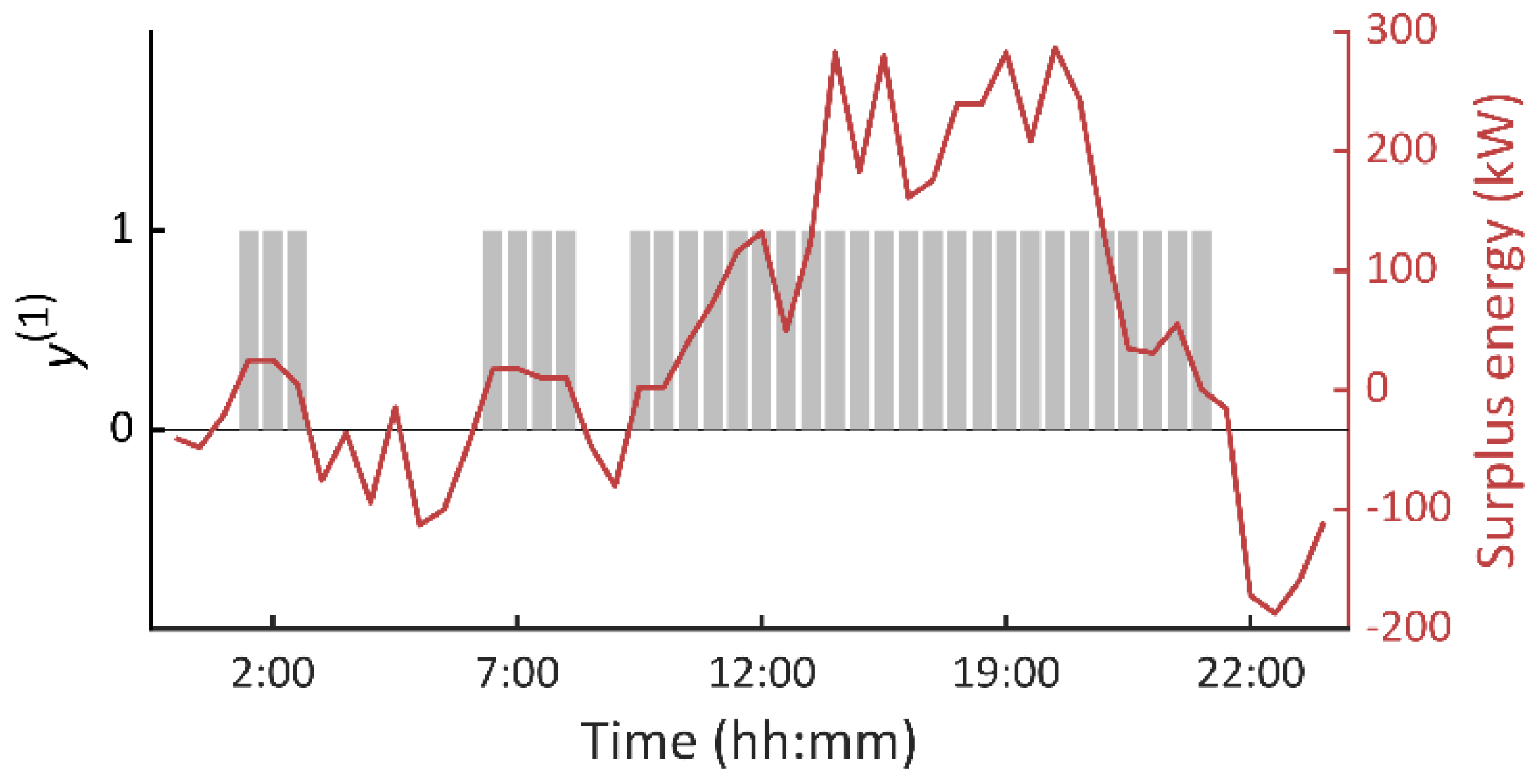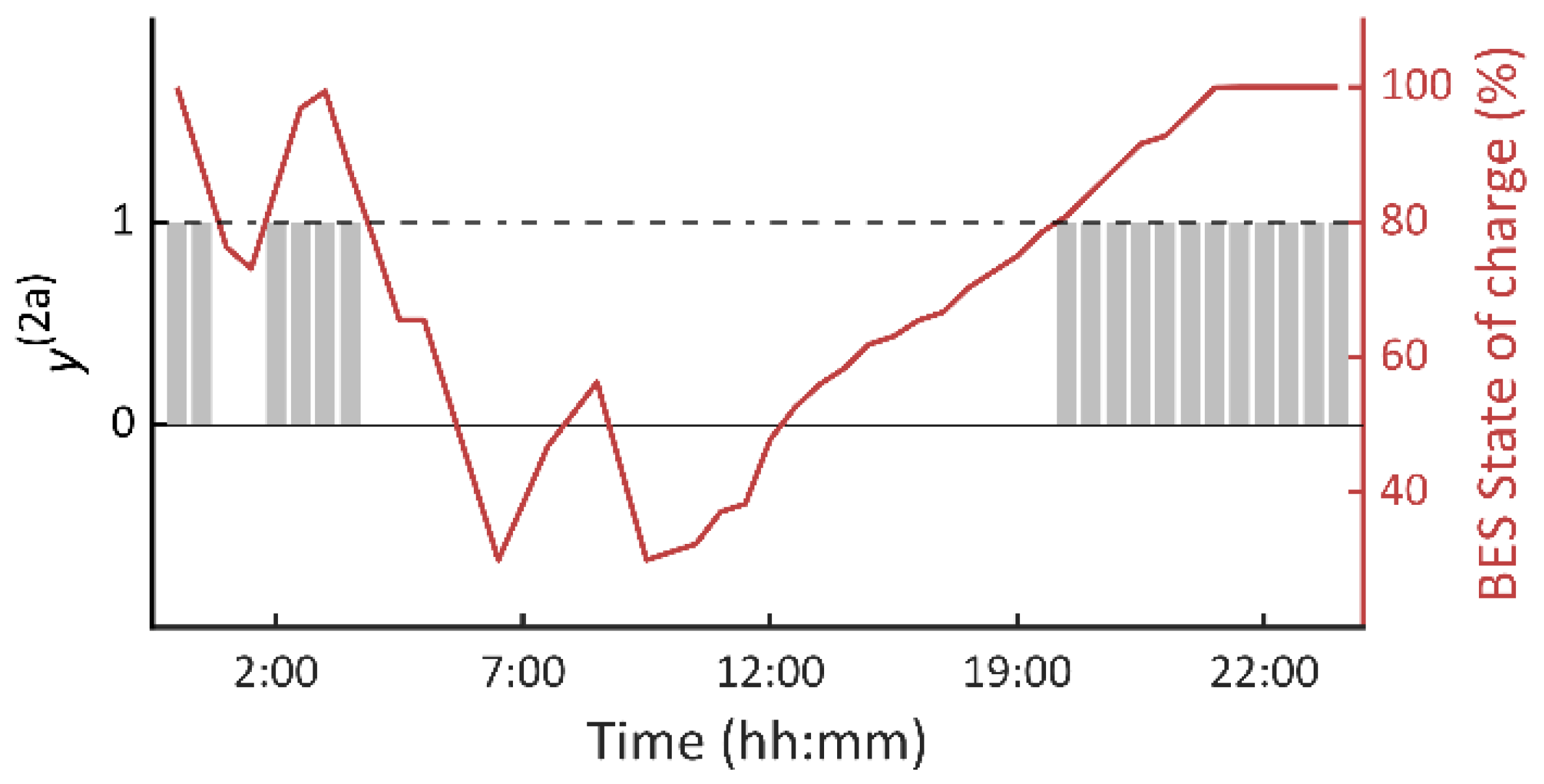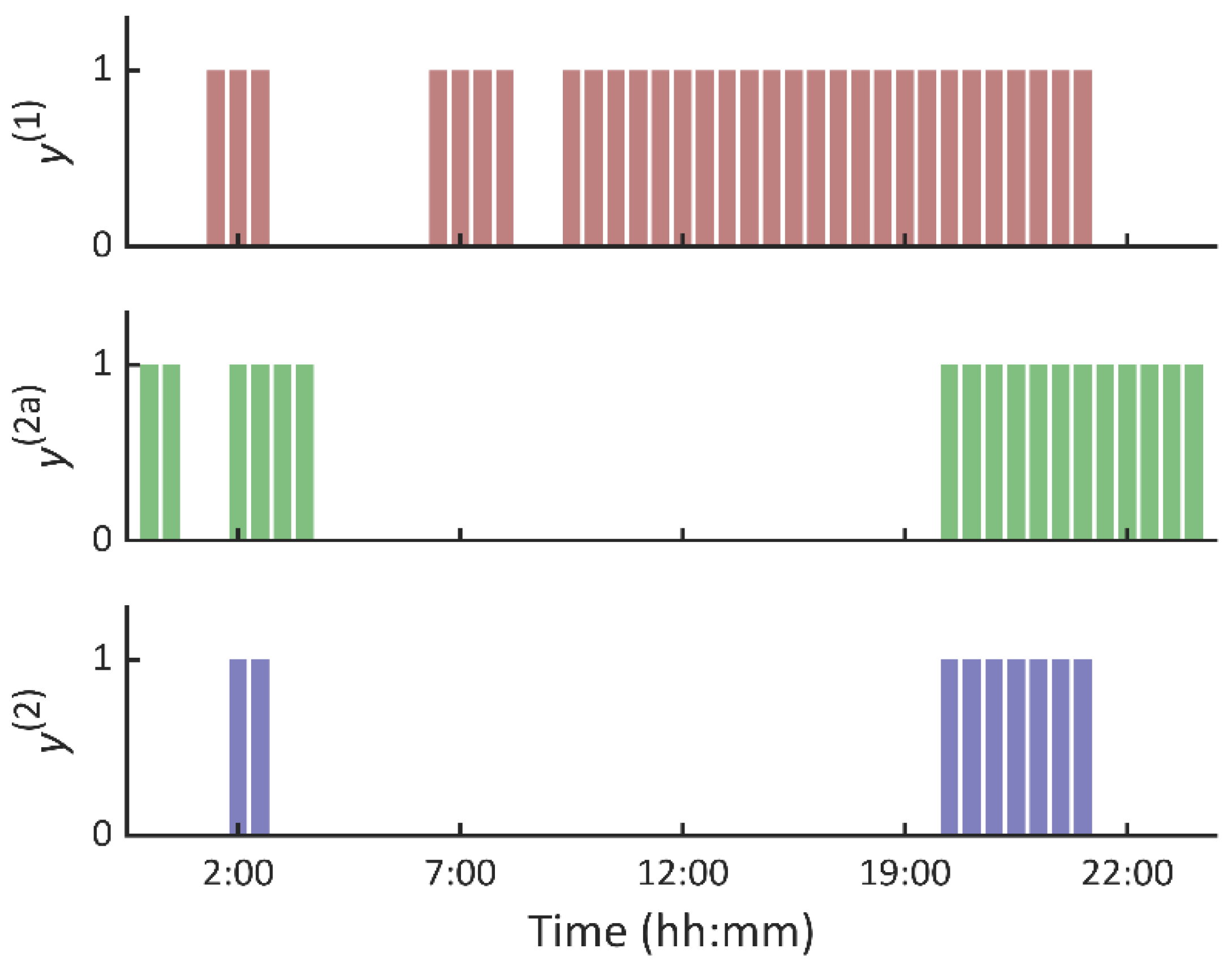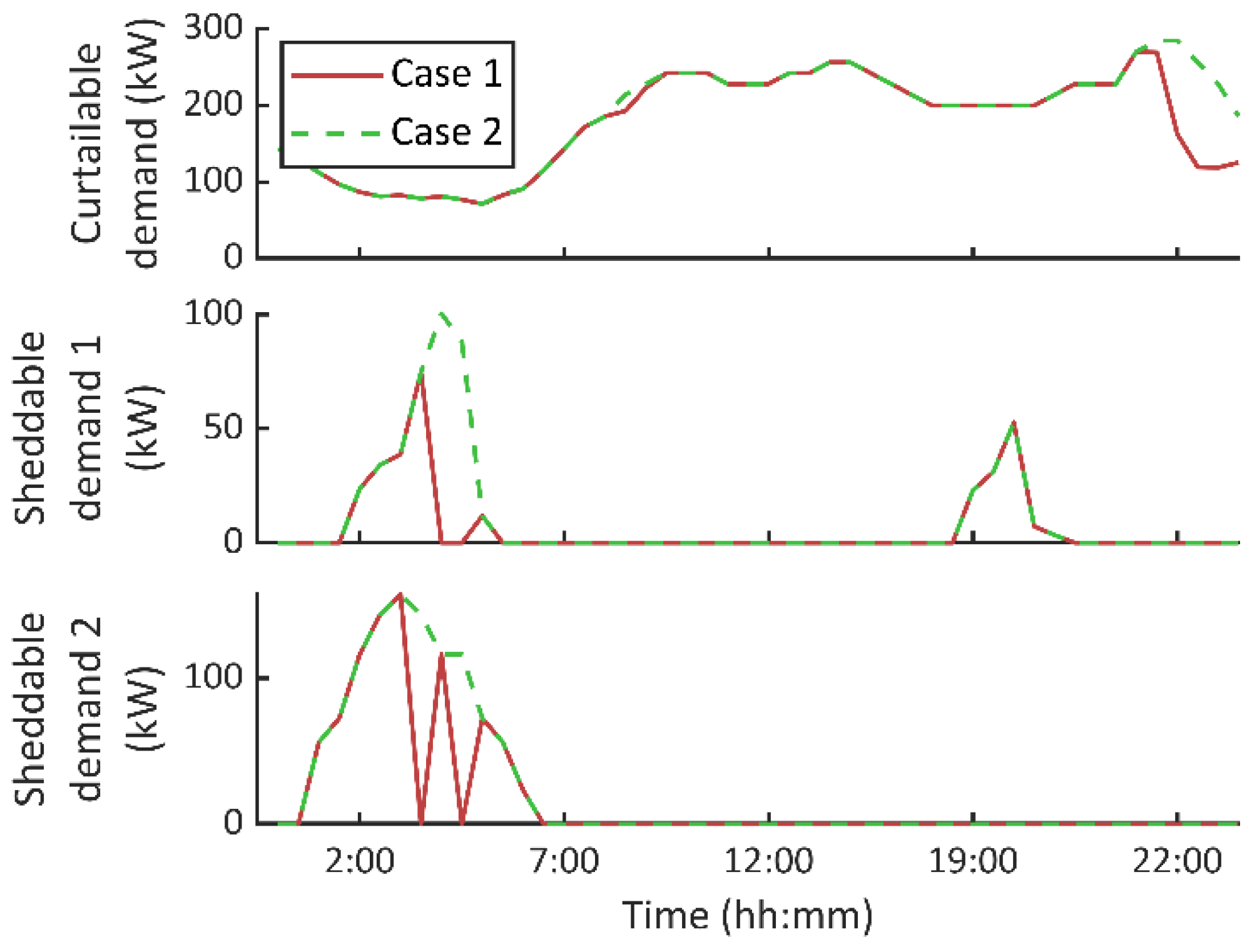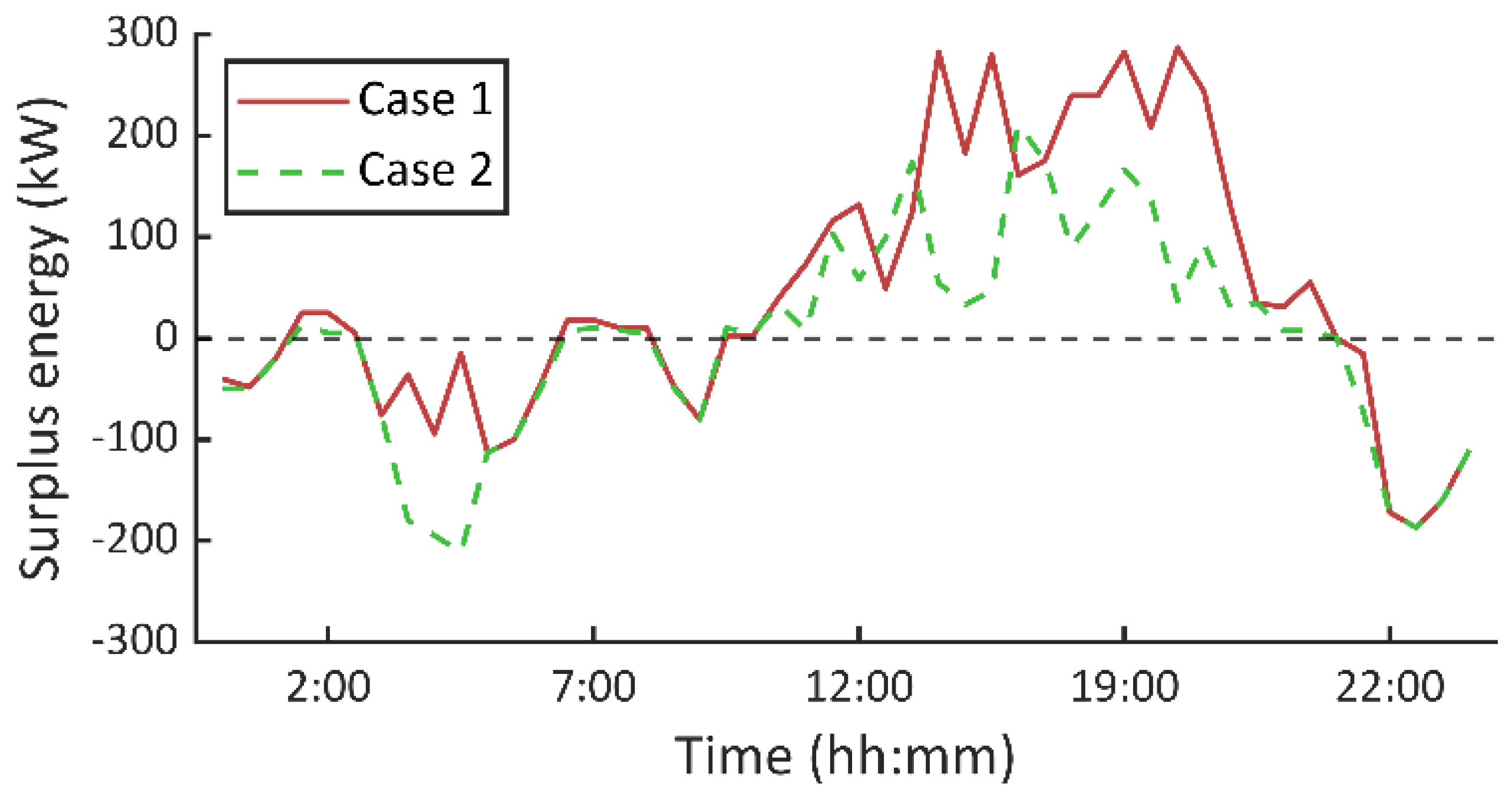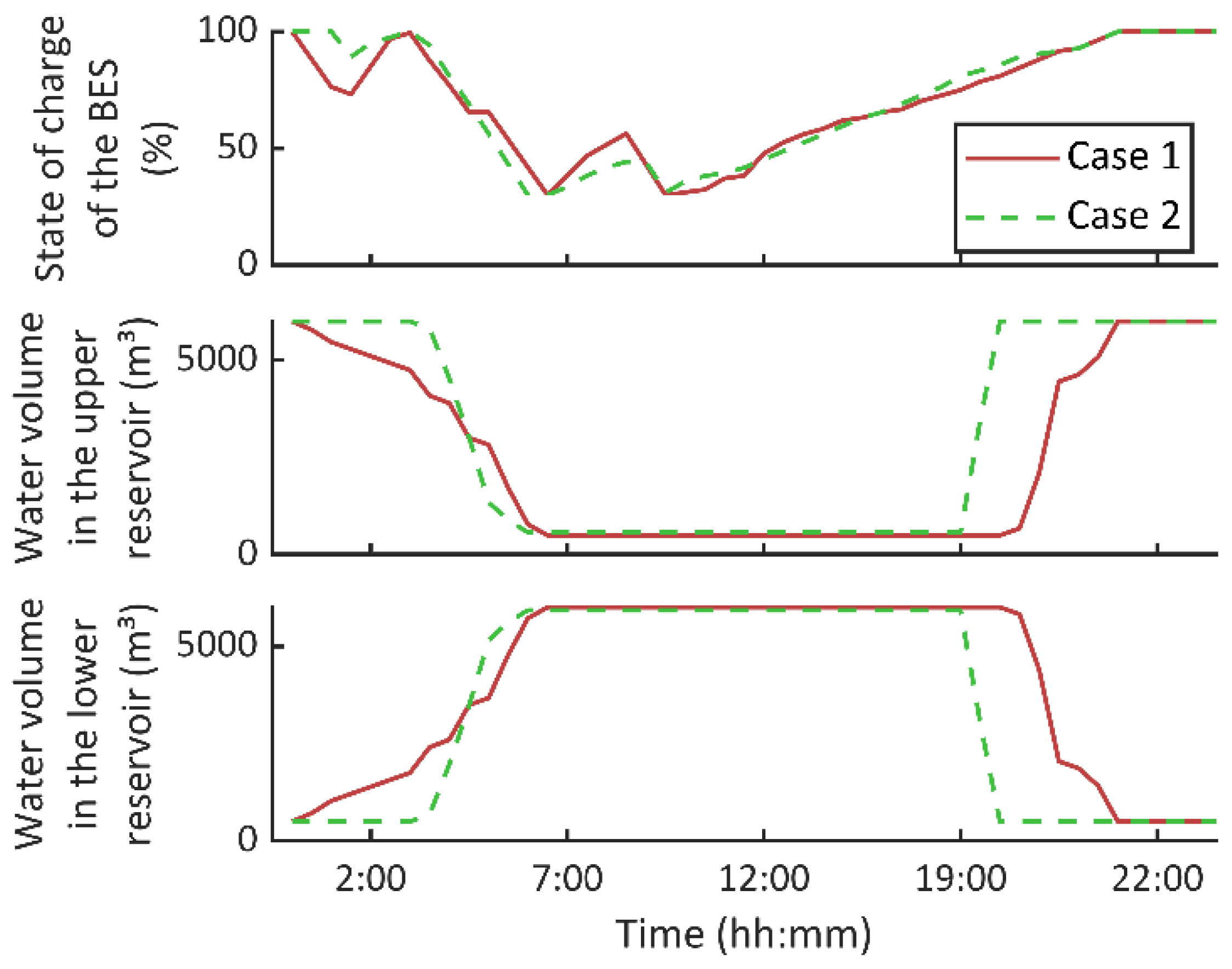1. Introduction
Small, isolated grids are used for many decades in remote areas, where supply from the main grid is either difficult to avail due to the topology or frequently disrupted because of climatic conditions [
1]. Conventionally, diesel generators based on nonrenewable fuel sources have been the most common choice for generating electricity in these isolated systems. However, gradual reduction of fossil fuel consumption, poor energy efficiency and environmental pollution are major problems that limited the use of such generators in remote areas. The use of renewable resources such as photovoltaic (PV) and wind generators (WGs) at the distribution level has provided numerous technical, economic and environmental benefits and can be considered to be a viable solution for remote communities [
2]. However, the uncertain behavior and variability of renewable-based generators lead to the fluctuation of net load considerably and need extra flexibility resources to cope with the inherent intermittency of these sources [
3]. In addition, in the circumstance where the generation of PVs and WGs are more than the required demand, the excess power should be curtailed to provide a balance between the load and supply. Storage systems play a key role in providing power balance in such remote areas. Due to the advantages of smart grids, it is promising to operate local distribution grids as a microgrid (MG) to take maximum benefits of renewable resources.
MGs as part of active distribution networks are one of the best solutions to overcome the challenges stemming from the high penetration of distributed energy resources (DERs) in distribution networks [
4]. MGs are the conglomerate of several DERs, storage systems and loads with the ability to operate in both grid-connected and isolated modes. The use of MGs provides the ability to implement modern energy management means such as demand-side management and demand-response (DR) programs [
5]. Moreover, storage systems in MGs are effective devices for developing renewable resources, as they are the only solution to deal with the challenge of intermittency of renewable sources. Storage systems can store the excess generation of DERs when demand is low and can use the stored energy when facing a shortage of generation. Among various storage systems, pumped hydro storage (PHS) units can be planned to operate more efficiently in MGs [
6]. Nevertheless, optimal operation and coordination of several DERs and storage systems along with demand-response programs in isolated MGs is a very challenging issue that needs to be resolved.
A considerable amount of literature has been published on the optimal operation of DERs and storage systems in MGs. Vasudevan et al. [
7] presented a comprehensive review of energy management strategies for variable speed pumped hydro storage. The paper also provided a comparison between PHS and other storage systems using critical data analysis. Zhao et al. [
8] presented optimal management for an isolated MG consisting of several renewable-based sources and PHS to maximize the operating profit and cope with the effects of the intermittent renewable energies. DR is also used in the paper for peak load shaving. Alturki et al. [
9] has designed and optimized an isolated hybrid WG/PV/biomass/PHS system to minimize the cost of energy. Stochastic optimal scheduling of several DERs, a pumped-storage unit, heating storage and cooling storage considering incentive-based DRPs in MG is studied in [
10]. A scenario approach is employed to model the uncertain parameters of the model. In [
11], energy management and real-time control of a typical MG including PHS and other renewable resources for both electricity and water demand are investigated using fuzzy logic and artificial neural network. The outcomes of the paper confirm that the management system keeps the stored water level as the same as the programming technique, while the pump and turbine are regulated more cost-effectively.
Liang et al. [
12] propose optimal scheduling for an island MG consisting of a seawater-pumped storage station, PV, WG and diesel generator. The paper has presented a mathematical formulation for seawater-pumped storage stations. Optimal day-ahead scheduling for an isolated MG with renewable sources, PHS unit and DR is suggested in [
13]. For the PHS, a precise model is presented, and the uncertainty of renewable resources is also modeled accurately. A novel management framework to optimize the operation of a pumped storage unit and intermittent WG in a typical MG is given in [
14]. The uncertain parameters are modeled using the two-point estimate technique. Shi et al. [
15] present a scheduling scheme for a typical MG based on the coordination of hybrid energy storage and heat pump air-conditioning systems using fuzzy control theory. An optimal operation for an MG including several renewable resources and PHS considering DR is investigated with a mixed-integer nonlinear programming solver in [
16].
In [
17], a stochastic-based scheduling method for MGs encompassing electric vehicles and storage systems was developed. This model considers AC/DC systems and highlights the interaction of on-board batteries with other components in the grid. Likewise, a multiagent energy management strategy for isolated MGs was developed in [
18]. The mathematical model is based on the primal-dual method of multipliers to make the tool distributed and alleviate the computational cost of the optimization framework. An interval-based scheduling model was presented in [
19] for MGs encompassing batteries, PHS units and DR initiatives. In this model, uncertainties from energy prices and renewable sources are modeled using a novel interval formulation that accounts for confidence intervals in forecasts. In [
20], a hybrid robust methodology was proposed for multienergy MGs, including different vehicles, hydrogen, gas and electric subsystems. This model considers different uncertain models for each uncertain parameter involved.
As deduced from the literature above, literature regarding energy management in MGs is rich. However, most of the existing literature normally copes with only one type of storage technology. In addition, when different storage facilities are considered, optimal coordination among them is ignored or oversimplified. This is a simplistic assumption that disregards the different characteristics of each type of storage technology. For example, if a storage unit is devoted to long-term energy storage, it should be coordinated with batteries accordingly, which are normally focused on short-term energy storage. This paper tackles this issue by proposing a novel stochastic mixed-integer-linear-logical programming model for optimal scheduling of isolated MGs that comprises batteries and PHS systems (we choose these technologies because of their complemented features). In contrast to other papers, coordination among storage technologies is explicitly incorporated into the mathematical model by including a logical-based routine that considers the particularities of each storage technology. Various types of DR programs are also considered, and a benchmark case study is analyzed to validate the developed model and explore the effect of DR initiatives. As a major advantage of the developed methodology, it is worth mentioning its versatility, being easily adaptable to different layouts incorporating other storage technologies (e.g., hydrogen-based units). In addition, the mathematical problem is formulated as mixed-integer-linear programming (MILP), which ensures the global optimum reachability [
21]. Lastly, a simple stochastic-based model is presented to easily incorporate uncertainties into the problem.
In the rest of this paper,
Section 2 describes the isolated system under study.
Section 3 presents the stochastic optimal scheduling modeling for the considered MG.
Section 4 develops the mixed-integer-linear-logical programming model for optimal coordination of batteries and PHS.
Section 5 describes the stochastic framework for uncertainties modeling.
Section 6 presents a case study and various numerical results. The paper is concluded with
Section 7.
4. Mixed-Integer-Logical Programming Model for Optimal Coordination of PHS and BES
Combining various energy storage technologies may be a good alternative to exploit the advantages of the different storage systems and circumvent their weaknesses [
35]. The MG under study provides ‘green’ energy storage by means of BES and PHS. Batteries are able to provide an efficient, fast response; however, their storage capacity is normally limited by expensive components or environmental concerns [
36]. In this sense, PHS may effectively complement BES due to the fact that this technology is able to provide large, cost-effective storage capacity. However, its charging–discharging cycle is notably less efficient compared with batteries [
34].
To optimally exploit different storage technologies, they should be operated in a coordinated way. In addition, the green-oriented character of the storage system in the MG under study should not be ignored, i.e., only surplus energy from renewable sources must be stored. For the MG under study, we propose a coordination scheme for BES and PHS based on the following logical rules:
Since the proposed storage system is green-oriented, it can be only charged when surplus energy is produced from renewable sources. It means that only when the net demand is greater than zero, the charging processes of the storage systems are enabled.
Due to the fact that the BES has a very efficient cycle in comparison with PHS, batteries should be scheduled primarily, in detriment of the PHS system. In this sense, on face of eventual surplus renewable energy generation, the batteries should be charged first, giving them priority w.r.t. the PHS.
Charging (pumping) mode of the PHS should only be enabled when the state of charge of the BES is higher than a preset threshold (), which means that batteries are sufficiently charged. It means that batteries are unable to store much more energy and, therefore, additional storage capacity is needed. Under these circumstances, the PHS system is scheduled to pump water to the upper reservoir and thus exploit the remaining energy produced by renewable sources.
The coordination scheme proposed above is normally ignored in other works. One of the main contributions of the present methodology is that it considers them by means of logical rules that can be integrated within the mathematical model developed in
Section 3. As result, the original MILP model is extended to a mixed-integer-linear-logical framework that integrates the rules above as additional constraints. This mathematical model encompasses a set of binary variables that are equal to 1 when some of the rules above are satisfied.
Table 1 describes the introduced binary variables for logical modeling of the optimal coordination between BES and PHS, while the flowchart in
Figure 3 illustrates the relationship between the logical rules and the declared variables. In the following subsection, the mathematical model of the developed mixed-integer-logical programming framework is developed and explained.
For the MG under study, the surplus energy from renewable sources can be calculated as follows.
Indeed, the Equation (33) says if renewable potential (PV + WG) is higher than the net demand, then (33) is higher than zero and takes negative values otherwise. This logical ‘if’ condition is mathematically represented by
To mathematically model the ‘if’ condition (34), we use the ‘big M’ method [
32]. This approach consists of introducing a large positive number, namely,
, and a series of additional constraints. More specifically, the condition (34) can be linearized by imposing the constraints (35) and (36).
As observed, if , then , and, therefore, the equation (33) is taking positive values. In contrast, if , then , and thus, (33) could only take negative values. This way, the condition (34) can be elegantly represented by a simple set of two constraints.
The second logical rule says if surplus renewable energy remains and batteries are sufficiently charged, then pumping mode of the PHS is enabled. This condition is modeled by the variable
and mathematically represented as follows:
The condition (37) cannot be directly represented by linear constraints since it involves an ‘and’ condition. It is worth noting that the first condition of the ‘and’ statement has been already treated with the variable
. Hence, we could use the same approach to model the second condition. This way, we introduce the auxiliary variable
, which aims at modeling the following ‘if’ condition.
Now, the constraints (39) and (40) are analogous to (36) and (37), but for modeling the condition (38), by using the variable
.
Now, we can easily model the ‘and’ condition in (37) making use of the variables
and
. So, if these variables are equal to 1, then
is also equal to 1, and 0 otherwise. This condition is linearized by imposing the constraints (41) and (42).
As seen in (41) and (42), if both
and
are equal to 1, then
is forced to be equal to 1 as well (the reciprocal can be also easily verified since
is declared as a binary variable). The model is completed by the constraints (43) and (44), which limits the charging powers of the BES and PHS so that they cannot absorb more energy than the excess produced by renewable generators; this way, the storage system exploited in the studied MG is totally green and only supplied by renewable sources.
It is worth noting that bi-integer variables appear in (43) and (44), which can be linearized, introducing dummy variables and additional constraints (see
Appendix B).
Note that the rules (33)–(44) can be adapted to any other storage technology. In this regard, it is only necessary to change the powers and state-of-charge variables by their corresponding variables related to other technologies. For example, in case of hydrogen-based technologies, the state-of-charge can be replaced by the state-of-pressure [
29].
7. Conclusions
This paper has presented a mathematical model for optimal coordination of ‘green’ BES and PHS systems in isolated MGs including DR programs. Our proposal combines the traditional mixed-integer-linear programming model for optimal coordination of the different MG assets and responsive loads, with an original mixed-integer-logical programming framework for mathematically modeling a series of logical rules that enables an effective coordination of the different storage facilities. Furthermore, a simple stochastic programming paradigm has been proposed which exploits clustering techniques to keep the whole optimization procedure computationally tractable.
A case study has been presented to validate the developed mixed-integer-logical programming model. The numerical experiments have also served to analyse the effect of DR programs in MG operation. In this regard, a notable cost reduction is achieved by enabling demand participation (~38%). Notable monetary savings are possible due to a drastic reduction of DEG generation (~82%). Furthermore, it has been observed that the different responsive loads are programmed so that surplus energy from renewable sources is maximized.
It is worth commenting that the developed model shares a limitation with stochastic programming. Although this uncertainty model is normally assumed to be feasible and widely applicable, it requires accurate forecasts to be reliable. In this sense, the developed methodology can be adapted to other uncertainty models to overcome such drawbacks, which will be addressed in future works. Moreover, future research will be focused on developing similar optimization frameworks for other types of hybrid storage systems, which may encompass hydrogen tanks, supercapacitors or air-compressed storage systems.
